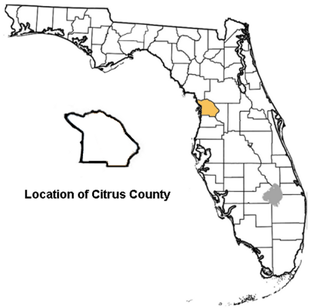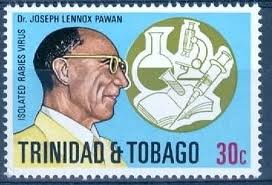In physiology, thermoception or thermoreception is the sensation and perception of temperature, or more accurately, temperature differences inferred from heat flux. It deals with a series of events and processes required for an organism to receive a temperature stimulus, convert it to a molecular signal, and recognize and characterize the signal in order to trigger an appropriate defense response.

Vampire bats, members of the subfamily Desmodontinae, are leaf-nosed bats currently found in Central and South America. Their food source is the blood of other animals, a dietary trait called hematophagy. Three extant bat species feed solely on blood: the common vampire bat, the hairy-legged vampire bat, and the white-winged vampire bat. Two extinct species of the genus Desmodus have been found in North America.

The New World leaf-nosed bats (Phyllostomidae) are bats found from southern North America to South America, specifically from the Southwest United States to northern Argentina. They are ecologically the most varied and diverse family within the order Chiroptera. Most species are insectivorous, but the phyllostomid bats include within their number true predatory species and frugivores. For example, the spectral bat, the largest bat in the Americas, eats vertebrate prey, including small, dove-sized birds. Members of this family have evolved to use food groups such as fruit, nectar, pollen, insects, frogs, other bats, and small vertebrates, and in the case of the vampire bats, even blood.

Desmodus is a genus of bats which—along with the genera Diaemus and Diphylla—are allied as the subfamily Desmodontinae, the carnivorous, blood-consuming vampire bats of the New World leaf-nosed bat family Phyllostomidae.

Draculin is a glycoprotein found in the saliva of vampire bats. It is a single-chain polypeptide protein composed of 708 amino acids, weighing about 88.5 kDa when reduced and 83 kDa when non-reduced, and selectively inhibits FIXa and FXa. It functions as an anticoagulant, inhibiting coagulation factors IX (IXa) and X (Xa) by establishing rapid equilibrium with factor Xa, and is the first natural polypeptide which has been described to show immediate anti-IXa and anti-Xa properties. In addition, Draculin inhibits the conversion of prothrombin to thrombin, preventing fibrinogen from converting to fibrin. These two processes inhibit blood coagulation thus keeping the blood of the bitten victim from clotting while the bat is drinking. The activation of factor X is a common point between the intrinsic and extrinsic pathway of blood coagulation. Activated factor X (FXa) is the sole enzyme that catalyzes the conversion of prothrombine into thrombin, which is vital in the coagulation cascade. Draculin is a member of the Lactoferrin family of proteins that functions as an antibacterial protein in other mammals, but has been co-opted in bat evolution to function as an anticoagulant.

The common vampire bat is a small, leaf-nosed bat native to the Neotropics. It is one of three extant species of vampire bat, the other two being the hairy-legged and the white-winged vampire bats. The common vampire bat practices hematophagy, mainly feeding on the blood of livestock. The bat usually approaches its prey at night while they are sleeping. It then uses its razor-sharp teeth to cut open the skin of its hosts and lap up their blood with its long tongue.

The hairy-legged vampire bat is one of three extant species of vampire bats. It mainly feeds on the blood of wild birds, but can also feed both on domestic birds and humans. This vampire bat lives mainly in tropical and subtropical forestlands of South America, Central America, and southern Mexico. It is the sole member of the genus Diphylla.

The white-winged vampire bat, a species of vampire bat, is the only member of the genus Diaemus. They are found from Mexico to northern Argentina and are present on the islands of Trinidad and Margarita.

The Mexican big-eared bat is a species of vesper bat endemic to Mexico. They are nocturnal and insectivorous. Their very large ears are located across their foreheads, and when captured, the bats are observed to curl their ears in a protective manner. The adults are usually brown colored, while the juveniles are usually a smokey brown color. They have small noses.
Desmodus draculae is an extinct species of vampire bat that inhabited Central and South America during the Pleistocene, and possibly the early Holocene. It was 30% larger than its living relative the common vampire bat. Fossils and unmineralized subfossils have been found in Argentina, Mexico, Ecuador, Brazil, Venezuela, Belize, and Bolivia.

In animals, rabies is a viral zoonotic neuroinvasive disease which causes inflammation in the brain and is usually fatal. Rabies, caused by the rabies virus, primarily infects mammals. In the laboratory it has been found that birds can be infected, as well as cell cultures from birds, reptiles and insects. The brains of animals with rabies deteriorate. As a result, they tend to behave bizarrely and often aggressively, increasing the chances that they will bite another animal or a person and transmit the disease.

Bats are flying mammals of the order Chiroptera. With their forelimbs adapted as wings, they are the only mammals capable of true and sustained flight. Bats are more agile in flight than most birds, flying with their very long spread-out digits covered with a thin membrane or patagium. The smallest bat, and arguably the smallest extant mammal, is Kitti's hog-nosed bat, which is 29–34 millimetres in length, 150 mm (6 in) across the wings and 2–2.6 g in mass. The largest bats are the flying foxes, with the giant golden-crowned flying fox reaching a weight of 1.6 kg and having a wingspan of 1.7 m.

The Inglis quarry or Inglis quarry sites 1A and 1C are assemblages of vertebrate fossils dating from the Pleistocene ~1.8 Mya—300,000 years ago, located in the phosphate quarries near the town of Inglis, Citrus County, northern Florida.

The Haile Quarry or Haile sites are an Early Miocene and Pleistocene assemblage of vertebrate fossils located in the Haile quarries, Alachua County, northern Florida. The assemblage was discovered during phosphate mining, which began in the late 1940s. Haile sites are found in the Alachua Formation. Two sites within the Ocala Limestone yielded Upper Eocene Valvatida and mollusks.

Joseph Lennox Donation Pawan MBE was a Trinidadian bacteriologist who was the first person to show that rabies could be spread by vampire bats to other animals and humans.

Vampire bats have developed a specialized system using infrared-sensitive receptors on their nose-leaf to prey on homeothermic (warm-blooded) vertebrates. Trigeminal nerve fibers that innervate these IR-sensitive receptors may be involved in detection of infrared thermal radiation emitted by their prey. This may aid bats in locating blood-rich areas on their prey. In addition, neuroanatomical and molecular research has suggested possible similarities of IR-sensing mechanisms between vampire bats and IR-sensitive snakes. Infrared sensing in vampire bats has not yet been hypothesized to be image forming, as it was for IR-sensitive snakes. While the literature on IR-sensing in vampire bats is thin, progress continues to be made in this field to identify how vampire bats can sense and use infrared thermal radiation.

The Florida bonneted bat or Florida mastiff bat is a species of bat in the genus Eumops, the bonneted bats or mastiff bats. Until recently, it was classified as a subspecies of Wagner's bonneted bat. It is endemic to southern Florida in the United States. This species has one of the smallest geographical distributions of any New World bat. It has been called "one of the most critically endangered mammal species in North America". It is protected under the Endangered Species Act.

The pristine mustached bat is an extinct Late Quaternary species of bat in the endemic Neotropical family Mormoopidae. It was distributed in Cuba and possibly Florida.

Chester Stock was an American paleontologist who specialized in the Pleistocene mammalian fauna of the Rancho La Brea tar pits. He served as a professor of geology at the California Institute of Technology, Pasadena.















